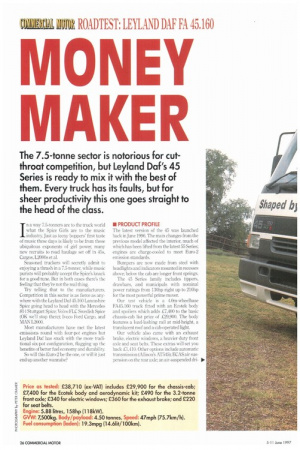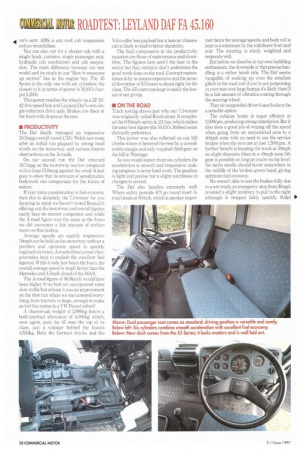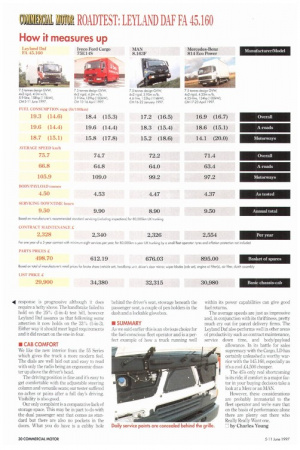NI N NI A K
Page 28

Page 30

Page 32

If you've noticed an error in this article please click here to report it so we can fix it.
The 7.5-tonne sector is notorious for cut throat competition, but Leyland Daf's 45 Series is ready to mix it with the best of them. Every truck has its faults, but for sheer productivity this one goes straight to the head of the class.
/n a way 7.5-tonners are to the truck world what the Spice Girls are to the music industry. Just as teeny hoppers' first taste of music these days is likely to be from those ubiquitous exponents of girl power, many new recruits to road haulage set off in 45s, Cargos, L2000s et al.
Seasoned truckers will secretly admit to enjoying a thrash in a 7.5-tanner, while music purists will probably accept the Spice's knack for a good tune. But in both cases there's the feeling that they're not the real thing.
Try telling that to the manufacturers. Competition in this sector is as fierce as anywhere with the Leyland Daf 45.160 Lancashire Spice going head to head with the Mercedes 814 Stuttgart Spice; Volvo FLC Swedish Spice (OK we'll stop there); Iveco Ford Cargo, and MAN L2000.
Most manufacturers have met the latest emissions round with four-pot engines but Leyland Daf has stuck with the more traditional six-pot configuration, flagging up the benefits of better fuel economy and durability.
So will this Euro-2 be the one, or will it just end up another wannabe?
• PRODUCT PROFILE
The latest version of the 45 was launched back in June 1996. The main changes from the previous model affected the interior, much of which has been lifted from the latest 55 Series; engines are charge-cooled to meet Euro-2 emission standards.
Bumpers are now made from steel with headlights and indicators mounted in recesses above; below the cab are longer front springs.
The 45 Series family includes tippers, drawbars, and municipals with nominal power ratings from 130hp right up to 210hp for the most powerful prime mover.
Our test vehicle is a 4.0m-wheelbase FA45.160 truck fitted with an Ecotek body and spoilers which adds 0,400 to the basic chassis-cab list price of £29,900. The body features a load-lashing rail at mid-height, a translucent roof and a cab-operated light.
Our vehicle also came with an exhaust brake, electric windows, a heavier duty front axle and seat belts. These extras will set you back £1,410. Other options include automatic transmission (Allison's AT545); ECAS air suspension on the rear axle; an air-suspended dri ver's seat; ABS; a sun roof; cab suspension and an immobiliser.
You can also opt for a sleeper cab with a single bunk, curtains, single passenger seat, hydraulic cab mechanism and cab suspension. The main difference between our test model and its rivals in our "How it measures up section" lies in the engine bay The 45 Series is the only one with six cylinders; the closest to it in terms of power is MAN's fourpot L2000.
This power reaches the wheels via a ZF S542 rive-speed box and Leyland Daf's own single-reduction drive axle. Brakes are discs at the front with drums at the rear.
• PRODUCTIVITY
The Daf finally managed an impressive 19.3mpg overall round GM's Welsh test route after an initial run plagued by strong head winds on the motorway and various bizarre obstructions on the A-roads.
On our second run the Daf returned 18.7mpg on the motorway section compared with a limp 15.9mpg against the wind. It just goes to show that no amount of aerodynamic bodywork can compensate for the forces of nature.
If your main consideration is fuel economy then this is definitely the 7.5-ton ner for you (bearing in mind we haven't tested Renault's offering yet). Its motorway and overall figures easily beat its nearest competitor and while the A-road figure was the same as the Nein we did encounter a fair amount of surface water on that section.
Average speeds are equally impressive: 70mph can be held on the motorway without a problem and optimum speed is quickly regained on twisty A-roads (these power characteristics help to explain the excellent fuel figures). While it only just beats the Iveco, the overall average speed is 4mph better than the Mercedes and 3.5mph ahead of the MAN.
The A-road figure of 66.8kmih would have been higher if we had not encountered some slow traffic but at least it was an improvement on the first run where we encountered everything from tractors to dogs...enough to make us feel like extras in a VW Passat advert!
A chassis-cab weight of 2,990kg leaves a body/payload allowance of 4,500kg which, once again, puts the 45 near the top of its class, just a whisker behind the lveco's 4,530kg. Both the German trucks and the Volvo offer less payload but a heavier chassiscab is likely to lead to better durability The final components in the productivity equation are those of maintenance and downtime. The figures here aren't the best in the sector but they certainly don't undermine the good work done on the road. Contract maintenance is by no means expensive and the annual downtime of 9.5 hours is about right for the class. The 45's parts package is easily the lowest of our group.
• ON THE ROAD
Track testing shows just why our 7.5-tonner was originally called Roadrunner. It completed the 0-50mph sprint in 23.1sec which makes the next best figure (the MAN's 30.8sec) seem distinctly pedestrian.
This power was also reflected on our hill climbs where it bettered the rest by a considerable margin and only required third gear on the hill at Wantage.
As you would expect from six cylinders the acceleration is smooth and responsive; making progress is never hard work. The gearbox is light and precise bar a slight notchiness in changes to second.
The Daf also handles extremely well. Where safety permits it'll go round most Aroad bends at 50mph, which is another impor
tant factor for average speeds, and body roll is kept to a minimum by the stabilisers front and rear. The steering is nicely weighted and responds well, But before we dissolve in our own bubbling enthusiasm, the downside of that precise handling is a rather harsh ride. The Daf seems incapable of soaking up even the smallest glitch in the road and if you're not porpoising in your seat over large bumps it's likely there'll be a fair amount of vibration coming through the steering wheel.
That air-suspended driver's seat looks to be a sensible option.
The exhaust brake is super efficient at 2,500rpm, producing strong retardation. But it also does a good job of wiping off the speed when going from an unrestricted area to a 40mph zone with no need to use the service brakes when the revs are at just 1,500rpm. A further benefit is keeping the truck at 50mph on slight descents. Once in a 40mph zone 5th gear is possible as long as you're on the level: the tacho needle should hover somewhere in the middle of the broken green band, giving optimum fuel economy.
We weren't able to test the brakes fully due to a wet track; an emergency stop from 30mph revealed a slight tendency to pull to the right although it stopped fairly quickly. Pedal 44 response is progressive although it does require a hefty shove. The handbrake failed to hold on the 25% (1-in-4) test hill, however Leyland Daf assures us that following some attention it now holds on the 33% (1-in-3). Either way it should meet legal requirements and it did restart on the one-in-four.
• CAB COMFORT We like the new interior from the 55 Series which gives the truck a more modern feel. The dials are well laid out and easy to read with only the radio being an ergonomic disaster up above the driver's head.
The driving position is fine and it's easy to get comfortable with the adjustable steering column and versatile seats; our tester suffered no aches or pains after a full day's driving. Visibility is also good.
Our only complaint is a comparative lack of storage space. This may be in part to do with the dual passenger seat that comes as standard but there are also no pockets in the doors. What you do have is a cubby hole behind the driver's seat, stowage beneath the passenger seat, a couple of pen holders in the dash and a lockable glovebox.
• SUMMARY As we said earlier this is an obvious choice for the fuel-conscious fleet operator and is a perfect example of how a truck running well within its power capabilities can give good fuel returns.
The average speeds are just as impressive and, in conjunction with its thriftiness, pretty much cry out for parcel delivery firms. The Leyland Dal also performs well in other areas of productivity such as contract maintenance, service down time, and body/payload allowance. In its battle for sales supremacy with the Cargo, LD has certainly unleashed a worthy warrior with the 145.160. especially as it's a cool £4,500 cheaper.
The 45's only real shortcoming is its ride; if comfort is a major factor in your buying decision take a look at a Merc or an MAN.
However, these considerations are probably immaterial to the fleet operator and we're sure that on the basis of performance alone there are plenty out there who Really Really Want one.
7 by Charles Young




































































































